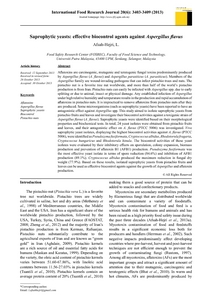Citation
Afsah Hejri, Leili
(2013)
Saprophytic yeasts: effective biocontrol agents against Aspergillus flavus.
International Food Research Journal, 20 (6).
pp. 3403-3409.
ISSN 1985-4668; ESSN: 2231-7546
Abstract
Aflatoxins are carcinogenic, mutagenic and teratogenic fungal toxins predominantly produced by Aspergillus flavus (A. flavus) and Aspergillus parasiticus (A. parasiticus). Members of the Aspergillus family are wound-invading pathogens that can infect pistachio trees and nuts. The pistachio nut is a favorite tree nut worldwide, and more than half of the world's pistachio production is from Iran. Pistachio nuts can easily be infected with Aspergillus spp. due to early splitting or due to animal, insect or physical damage. Any established infection of Aspergillus under high relative humidity and temperature results in the production and rapid accumulation of aflatoxins in pistachio nuts. It is impractical to remove aflatoxins from pistachio nuts after they are produced. Some microorganisms (such as saprophytic yeasts) have been reported to have an antagonistic effect against Aspergillus spp. This study aimed to isolate saprophytic yeasts from pistachio fruits and leaves and investigate their biocontrol activities against a toxigenic strain of Aspergillus flavus (A. flavus). Saprophytic yeasts were identified based on their morphological properties and biochemical tests. In total, 24 yeast isolates were obtained from pistachio fruits and leaves, and their antagonistic effect on A. flavus (PTCC 5006) was investigated. Five saprophytic yeast isolates, displaying the highest biocontrol activities against A. flavus (PTCC 5006), were identified as Pseudozyma fusiformata, Cryptococcus albidus, Rhodotorula fragaria, Cryptococcus hungaricus and Rhodotorula hinula. The biocontrol activities of these yeast isolates were evaluated by their inhibitory effects on sporulation, colony expansion, biomass production and prevention of aflatoxin B1 (AFB1) production. Pseudozyma fusiformata was the most effective yeast isolate in terms of spore reduction (84.6%) and inhibition of AFB1 production (89.1%). Cryptococcus albidus produced the maximum reduction in fungal dry weight (77.9%). Based on these results, isolated saprophytic yeasts from pistachio fruits and leaves can be used as effective biocontrol agents against the growth of Aspergillus and aflatoxin production.
Download File
![[img]](http://psasir.upm.edu.my/41076/1.hassmallThumbnailVersion/Saprophytic%20yeasts%20effective%20biocontrol%20agents%20against%20Aspergillus%20flavus%20%283403-3409%29.pdf)  Preview |
|
PDF
Saprophytic yeasts effective biocontrol agents against Aspergillus flavus (3403-3409).pdf
Download (1MB)
| Preview
|
|
Additional Metadata
Actions (login required)
 |
View Item |

